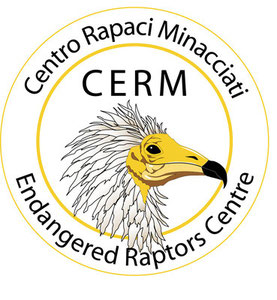
The captive-bred Egyptian Vultures, Sara and Tobia, were released in Italy in 2015. Both birds migrated to Africa after their release and have not been back to Italy until this year! At the end of August, they began their migration journey back to Africa. Where are they now?
Sara and Tobia
Sara and Tobia hatched at the CERM Endangered Raptors Centre (Italy) in 2015 and were released in the same year by the CERM Association on behalf of the Italian Ministry for the Environment. This was part of an experimental release programme led by the CERM, in collaboration with us here at the Vulture Conservation Foundation (VCF) and the Egyptian Vulture Captive Breeding Network. The project tests procedures to get crucial data on the feasibility and relevance of captive-breeding and reintroduction projects with this species. They were both fitted with GPS transmitters before being released, and we closely followed their progress.
Following their release, they migrated to Africa where they spent four years exploring Niger (Sara) and Mali (Tobia), and they finally returned to Italy in May 2019. Sara spent the previous two summers in northern Africa, mainly in Tunisia. Tobia did the same, but only in 2018. After spending four months wandering between Basilicata and Calabria, they left again for Africa at the end of August.
Migrating to Africa

During her migration journey, Sara spent 32 days in Sicily waiting for favourable winds to cross the Strait of Sicily. On 7 September at 11 a.m. she finally left for Cape Bon in Tunisia but due to unfavourable winds ended up to the island of Pantelleria. She arrived there at 5 p.m., after flying 130 km over the sea, at a speed of only 21 km/h. So, she spent the night there and the next morning she left at 8 a.m., arriving at Capo Bon at 1:30 p.m., covering another 82 km over the sea at an average speed of only 14 km/h. Low speeds reveal a particular difficulty for these birds to be able to complete the journey that they usually make at about 40 km/h.
Sara was not alone on this adventurous journey – she had Tobia on her side. Thanks to GPS data, we saw that the two met in the skies of Trapani on 6 September at 11 a.m., both coming from different areas. Together they went to Marettimo Island, where they roosted in the same place. The next day they left at the same time following the same route, same stopping points in Pantelleria, same route to Cape Bon and finally the same stopping place in Tunisia.
Sara travelled another 740 km into the Sahara desert. She still needs about 1,500 km to reach her usual wintering area in Niger. Thanks to the GPS that uses a particular satellite system (Argos) we can follow her wherever she is.
Tobia hasn’t been sending signals for the last week (last in Tunisia). This is normal since his GPS uses the mobile phone system to send the data and in the area, the telephone antennas are very rare. We hope that he is well and perhaps is still travelling with Sara.
Update 09/10/2019
Sara reached Niger!
The young Egyptian Vulture has reached her usual wintering grounds – Niger! She came back to Italy in May, and was monitored by dozens of volunteers along her Italian travels.
She hatched at CERM in 2015 and released in the same year, in these four years she travelled over 51.000 km, crossing the Sahara Desert 7 times (4 of which to go to the north of Algeria to spend the summers of 2017 and 2018).

Egyptian Vultures in Italy
Once found all along Italy’s Tyrrhenian coast from Liguria to Calabria, the Egyptian Vultures suffered an 80% decline in its population since the 1970s due to poaching, disturbance of nesting sites, reduction in their food supply and illegal poisoning. With less than an estimated 10-12 breeding pairs in Italy, the Egyptian Vultures is considered critically endangered in the country. The population is concentrated mainly in the south of Italy, in Sicily (8 breeding pairs in 2018) and the south of the Italian peninsula around Basilicata and Calabria (3 pairs in 2019).
The project
From 2003 to 2019, the CERM Association released 33 captive-bred Egyptian Vultures testing three different release techniques: fostering (2003), which was negatively assessed and thus abandoned, hacking (2004-2019), which has given the best results up to now, and delayed release (2017).
The Vulture Conservation Foundation supports the project by providing GPS tags as well as supporting the monitoring of these birds since 2015.

